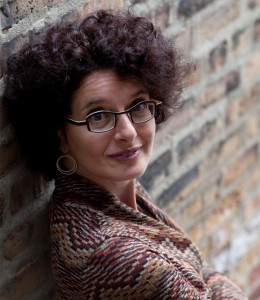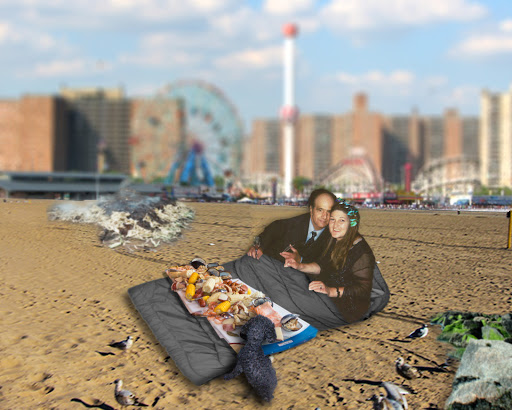Today SevenPonds speaks with Nancy Gershman, a memory artist who creates “Dreamscapes” for people in hospice and their families. A Dreamscape is a photo collage that serves as a physical image of a memory or something the ill/deceased person wanted to do but never had the chance to achieve. Nancy works at a hospice with the Visiting Nurse Service of New York at Bellevue Hospital.
Lucas: Thank you so much for taking the time to talk with me! What is your background, and how did you start making Dreamscapes?
Nancy Gershman: I used to work in the advertising world, and was always drawn to collage and cutting and pasting. I originally did it to help soothe my own anxiety. At my son’s bar mitzvah, we were missing a grandmother, and I felt sad that she wasn’t there. So I decided to make a photorealistic picture that brought her to the ceremony, and I realized I was onto something. The thought was to make a “Dreamscape” which consolidates different periods of time into one image in a hierarchical way to show why someone did what they did with their life. I create them with Photoshop. The idea is to take pieces of each positive memory and see what the connection is between all of them, to tweak it to complete the memory.

Nancy Gershman Credit: ArtForYourSake.com
Lucas: What does the process entail and how can Dreamscapes help bereaved families?
Nancy: I work at a hospice at Bellevue with the Visiting Nurse Service of New York. I find that early intervention is the most helpful to people, meaning I will work with the family before their loved one dies. So I will go into a patient’s room and ask, “How would you like a picture of a memory you have or wish you had?” I never use the terms “death” or “memorial.”
The more distressed people may associate my questioning with death and avoid it. But the others enjoy sitting down with me. I put on my personal historian hat, and we brainstorm and get everything we need to make this picture of a memory that happened or didn’t happen because their loved one got sick. This early intervention is helpful because many times when a patient dies, the families want to create a photo collage or a “life review.” And with the Dreamscape, I’ve already helped them prepare and organize their thinking about what kind of person their loved one was. When you’re distressed, it’s hard to nail down what was so unique about that person.
Lucas: Do you work with the patient themselves or the family members?
Nancy: I work primarily with the family members. If the patient is well enough and wants to be involved, or wants to confirm what their family member said, then I engage with them. For instance, there was one man I made a Dreamscape of who was in a mariachi band with his brothers. When I made the Dreamscape, he was heavily sedated. I asked his family member if he had any regrets or a wish or dream that he hadn’t fulfilled, and she said that he always wanted to play at the Wailing Wall in Israel. I was like, “Wow, this is incredible.” And the patient kind of nodded.
Then I found a YouTube video that included the wall and made a still out of that; I found just the right part of the wall. And when I went to Israel earlier this year, I thought a lot about that man and his mariachi band, and why he wanted to be there. There are just so many unbelievable, beautiful stories like that.
Lucas: How many Dreamscapes have you made?
Nancy: I have worked in hospice for two and a half years. I’ve worked with 337 families, and have made 138 Dreamscapes. Roughly 40 percent would make the Dreamscape with me and 60 percent would just talk. Some families would only go part of the way and brainstorm what it would look like, but we wouldn’t actually create the complete Dreamscape.

Example of a Dreamscape
Credit: ArtForYourSake.com
Lucas: Wow that is amazing! I wouldn’t have guessed that you’ve made that many. How do people usually use the Dreamscape when it’s complete?
Nancy: There are many ways you can use them! One way people tend to use them is to upload the Dreamscape to Facebook. When people are wounded or grieving, they sometimes keep to themselves and don’t want to see people. But when they have this, they put themselves out there and get sustenance from positive things people say. They had fun making it, and are now having a different kind of fun by having people guess where this photo came from and how it originated. What’s also cool is that if they choose to make a physical copy, you can make it as small as a credit card and keep it in your wallet. Some people have also chosen to have T-shirts made.
Lucas: Do you decide which story to tell in the Dreamscape?
Nancy: I sort of act as a catalyst. When people “get it,” in the sense of what a Dreamscape can open up as far as possibilities, they’ll dictate and say, “I want this, this or this.” Other people speak too generally about the person. Then I feel like I don’t have enough to get a true sense of what made that person amazing. So I will have to ask a lot of questions to get specific answers. Then I lock on something that shows specifically how this story belongs to this one person and no one else.
Check back next week for Part Two of our interview with Nancy Gershman.

 How Can a “Dreamscape” Help Grieving Families Heal?
How Can a “Dreamscape” Help Grieving Families Heal?


 “In Case You Don’t Live Forever” by Ben Platt
“In Case You Don’t Live Forever” by Ben Platt
 Our Monthly Tip: Make an “In Case of Death” File to Ease Loved One’s Grief
Our Monthly Tip: Make an “In Case of Death” File to Ease Loved One’s Grief
 Passing of Beloved Comedian Births a New Comedy Festival
Passing of Beloved Comedian Births a New Comedy Festival














